History of the MG Car Club: Part 1
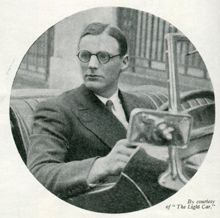
 The first complete MG Car Club History was compiled by the late Mike Hawke and published in 2000 to celebrate the 70th Anniversary of the Club. The book was soon out of print, there was clearly a need for a replacement and Peter Browning volunteered to edit an enlarged and updated version. This is the first of a multi-part series.
The first complete MG Car Club History was compiled by the late Mike Hawke and published in 2000 to celebrate the 70th Anniversary of the Club. The book was soon out of print, there was clearly a need for a replacement and Peter Browning volunteered to edit an enlarged and updated version. This is the first of a multi-part series.
IN THE BEGINNING 1930-32 – HAROLD HASTINGS
It is a little over six years since I put together a page of readers’ correspondence for The Light Car including the letter that started it all. It appeared over the signature of one Roy Marsh and was published in the issue of September 5, 1930.
Why Not An MG Club?
Being a very interested reader of The Light Car and Cyclecar, I notice that a number of one make clubs have been formed lately with very satisfactory results. Now Midget enthusiasts, what about an MG Car Club? There are hundreds of you and surely some very enjoyable social runs and trials could be arranged. Perhaps MG owners would let me have their opinions on the idea.
Quite brief and to the point, it took immediate effect. That was as inevitable as the subsequent growth of the Club. You cannot have a lot of people rushing round the country in cars like MGs without wanting to get together.
Various people wrote to various other people. HM Post Office was enriched by numerous pennies inserted in numerous slots and one or two more letters appeared in The Light Car. The upshot of it all was an announcement in that journal of an inaugural rally on October 12 for the purpose of formally bringing the Club into being.
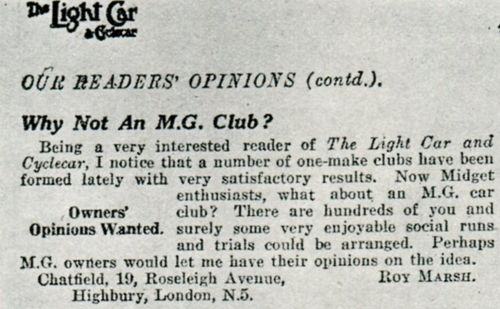
It was part of my job, of course, to keep in touch with events. That would have applied to the formation of any motor club. In this case, however, it was not so much a job as a joy because I was myself running an M-type Midget and felt just as everyone else felt about those wonderful little motors, terrifically enthusiastic. They were quite unlike anything else in their day and it was not until mine had provided me with well over 30,000 miles of very good motoring that I reluctantly parted with it.
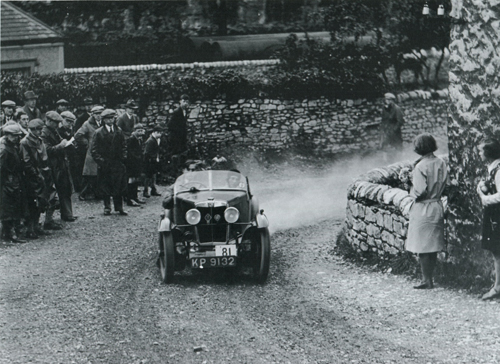
All this is a little beside the point and yet in a way it isn’t, because owners of T-Types and other recent models may not realise that the old original Midget inspired just as much enthusiasm in its time as the T does today.
Anyhow, the rally duly took place at the Roebuck Hotel, near Stevenage (Hertfordshire), on the Great North Road. Over 30 MGs turned up, all but two of them Midgets, and the car park looked rather like the dispatch bay at the works. Inside the pub everyone looked a little awkward, felt it was up to them to do something but didn’t quite know what. Co-conspirators Roy Marsh and John Thornley stepped into the breach, however, and a meeting was soon in full swing. (John Thornley, of course, is the man who now tells you how much it will cost to mend the bits you break, although at that time he had no connection with the works).
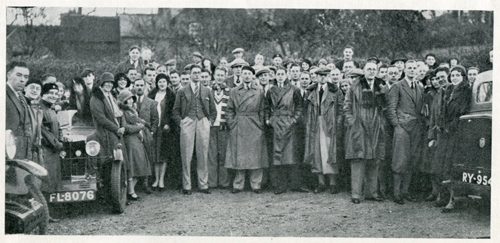
At the meeting, I remember him explaining how he had made contact with Roy Marsh immediately following the letter in The Light Car and offered to take on the duties of secretary pro tem. On Marsh’s agreeing, he had approached Mr Cecil Kimber and obtained from the MG chief a promise of full support; a provisional design for a badge was also produced for inspection and approved and suggestions put forward regarding subscriptions and so on. He concluded, “If you will let me be secretary for the time being, I think I can make the Club a success,” which, when you come to think of it, was a fairly stout undertaking to make to a lot of strangers.
After a little more discussion, the MG Car Club was formally constituted; Thornley was enthusiastically voted secretary, a committee elected, and everyone sat down to an overdue tea. Forming a club is one thing. Turning it into a going concern is another.
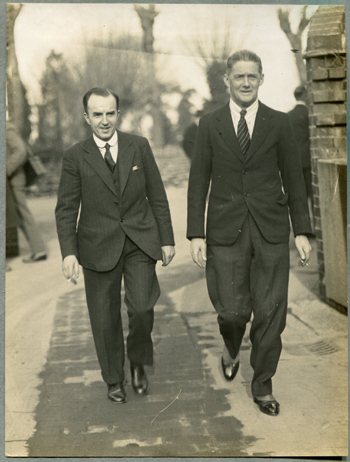
The immediate success of the Club can be gathered from the fact that over 50 cars turned out on this occasion. This large number rather upset the organisers’ calculations and the idea of a convoy run had to be abandoned; instead, members were asked to find their own way to Berkhamsted, which they did by promptly losing themselves and meeting each other going in opposite directions in narrow lanes. The resulting confusion effected a high percentage of introductions so that, by the time the King’s Arms was reached, lots of members knew lots of others and everyone was satisfied.
At Berkhamsted, a member of the local constabulary did yeoman service by standing in the middle of the road and waving members into the hotel yard. This he did with the greatest insistence to every MG that attempted to pass and thereby performed some quite useful recruiting. Thanks to his efforts and the presence of others who had been unable to turn up earlier, the gathering of members and friends at tea numbered well over a hundred.
A week or two later, Thornley rang me up and we met for lunch to discuss the prospects of a trial. The Chilterns (South East England) seemed the obvious district and I promised to find him some hills and draw up a set of regs. Early in the New Year, we got down to the route question in earnest and started a series of extraordinarily muddy expeditions. Arch Mudlarkers were Ernest Wood, the trials secretary, Norman Eames, one of the committee, Thornley and myself. We generally ended up at the King’s Arms wondering whether we were going to be thrown out for carting such large quantities of Chilterns’ chalk into a clean hotel but a tolerant management put up with us without complaint.
The classic occasion during these expeditions was when we found ourselves stuck in a sea of mud at the foot of Light Car’s Lament just as it was getting dark one bleak afternoon. We couldn’t get up Light Car’s Lament and after making the cars face the other way by dint of incredible effort, we found that they would not go up the hill and would not come down either. Prospects for a good trial seemed encouraging!
Eventually we decided on a course to our liking and some one finger efforts on a typewriter produced a route card that the rest of the committee could understand, so everything was set for the regs to go out and the entries to come in, we hoped.
In the meantime, the Club held its first annual dinner. This took place on January 9, 1931 at the Mecca Restaurant, Ludgate Hill (City of London), with Mr Kimber in the chair. Amongst the guests was the Earl of March (now the Duke of Richmond and Gordon). Mr Kimber made a characteristically amusing speech, gave some interesting facts about the Midget with which George Eyston was even then starting his record breaking habits, and concluded by promising a donation of 50 guineas towards the Club funds.
John Thornley returned thanks, mentioned that the membership figure was nearing the 200 mark and read a telegram from Sir William Morris (now Lord Nuffield, of course) consenting to become Patron of the Club. Everyone was terrifically enthusiastic and the function registered one more success for the Club.
The affair was also noteworthy as marking the birth of another MG tradition, for an item on the account subsequently rendered by the restaurant read, “To six spoons, bent and unfit for further use, 6s.” or some such sum. (Great oaks from little acorns grow.)
Three weeks later on February 15 the first Chilterns Trial was held. It marked, incidentally, what I believe was the first ban on competition tyres; a ban I had suggested because many members were new to the trials game and might be deterred from entering if they thought it meant spending a five pound note to put themselves on a level footing with the regular trials men.
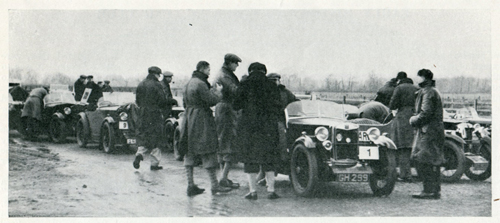
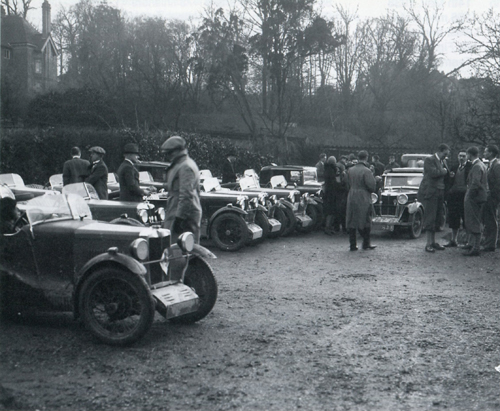
An entry of 60 had been obtained but ’flu was in fashion and 50 drivers actually started, amongst them Mrs. Kimber who drove a Midget, Robin Mere who is now more often organising than organised against, and Stanley Kemball whose office in University Motors the committee regularly borrowed for its meeting.
Here is a brief summary of what happened and where: Start, The Lambert Arms, Aston Rowant; finish, Ashley Green; hills: Lewknor (1 failure); Kingston Blount down hill brake test (24 drivers lost marks); Kop Hill slow climb (30 lost marks including 12 who stopped entirely); Kimble Lane (16 failures); Water Works Hill restarting test (3 lost marks); Hawridge (6 failures); Light Car’s Lament (22 failures). Weather bright sunshine after a week of rain. Best performance, W. H. Haden (Midget); first-class awards 9, second class 13, retired, 1.
Following the event, members adjourned to the King’s Arms for tea and afterwards the annual general meeting was held and brought to an end what, if not a complete year, was virtually the Club’s first season.
One other event remains to be chronicled to make this record of the beginnings of the MGCC complete, although actually it did not take place until May 7, 1932. I refer, of course, to the Abingdon–Abingdon.
The trial was noteworthy first because it marked the beginning of a very successful series and second because it was, I think, the first occasion on which a one make club opened its entry lists to other clubs. In selecting the hills, we were lucky in securing the help of that super trials enthusiast H.P. Baughan of Stroud (Gloucestershire), who has a better knowledge of his own district than any man I have ever met. When we explained what we wanted, he sat down and, without looking at a single map, dictated a route card that subsequently required no correction and very little amplification.
With this basis, arrangements went forward with unusual ease, the only hitch being a panic of major proportions caused, I regret to state, by one H.C. Hastings who had undertaken to obtain all the necessary direction cards from his office and having carefully wrapped them up in a neat parcel, left them in his bedroom at home.
To make matters worse, the discovery was not made until the indefatigable Wood, who had travelled down to Rodboro’ from Leigh-on-Sea (Essex) during the night, arrived at The Bear and roused the culprit from a peaceful sleep at about 6am, by demanding to see the wretched things.
By a stroke of luck, Thornley had put the remnants of a previous trial’s marking in his car. Frantic turning of white cards into red with the aid of a bottle of red ink was needed before the Cotswold end of the route could be marked.
The trial, which started and finished at the MG Works at Abingdon, was run off in bright sunshine and was great fun, particularly an emergency stop test in which competitors, on seeing a notice ‘MG CLUB STOP’, were expected to do so before reaching it. They were, of course, warned of the test, but not its location, and few of them expected it within half a mile of the start when they were still buttoning on their gloves and generally getting comfortably settled. Thornley’s bright notion of having the test so placed resulted in over half the 43 starters overshooting the line. So far as the hills were concerned, here is the list: Wragg hill (restart), Nailsworth Ladder, Quarhouse, Blackness, Mutton, Lies Lane, Besbury Common (acceleration and braking test), Battlescombe (timed climb).
Soon after that first Abingdon–Abingdon trial the Club began to grow very rapidly, which involved a great deal of work for its painstaking secretary. So, having given you my own early memories, I will leave the next stage of this narrative to his very capable pen. Enter J.W. Thornley.
Harold Hastings was on the editorial staff of The Light Car magazine and he put together a page of readers’ correspondence including the letter, which prompted the formation of the Club. As is clear from his report above he played a major role in getting the Club up and running. Harold went on to be the Midlands Editor of Motor magazine and as such was close to the heart of the motor industry. He was a personal friend of Cecil Kimber with whom he corresponded on a regular basis.
Roy Marsh disappeared from Club activities in the mid 1930s. The Club tried to find him, hunting references in London, pouring over street directories and phone books in London and the Midlands, his old London address having disappeared in the blitz. Eventually the Club gave up in despair until a member of the Natal Centre sent to Safety Fast! a small snapshot of an MG bearing a curious MGCC badge of a type that he had not seen before, This car, he said, was owned by a gentleman in Johannesburg who claimed to be a founder member; the badge was the original type and the gentleman’s name was Roy Marsh! He went to South Africa in 1933 and had been there ever since but he had not forgotten the fun he had with MGs back in Britain. He was elected an Honorary Life Member as a small gesture of appreciation of all the pleasure that many thousands of people have derived from the Club that he founded.
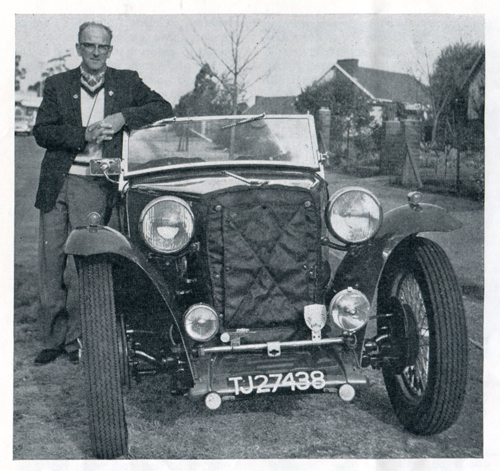
NAMGAR would like to thank Andy Knott, Editor, Safety Fast! magazine for permission to re-produce this article.

